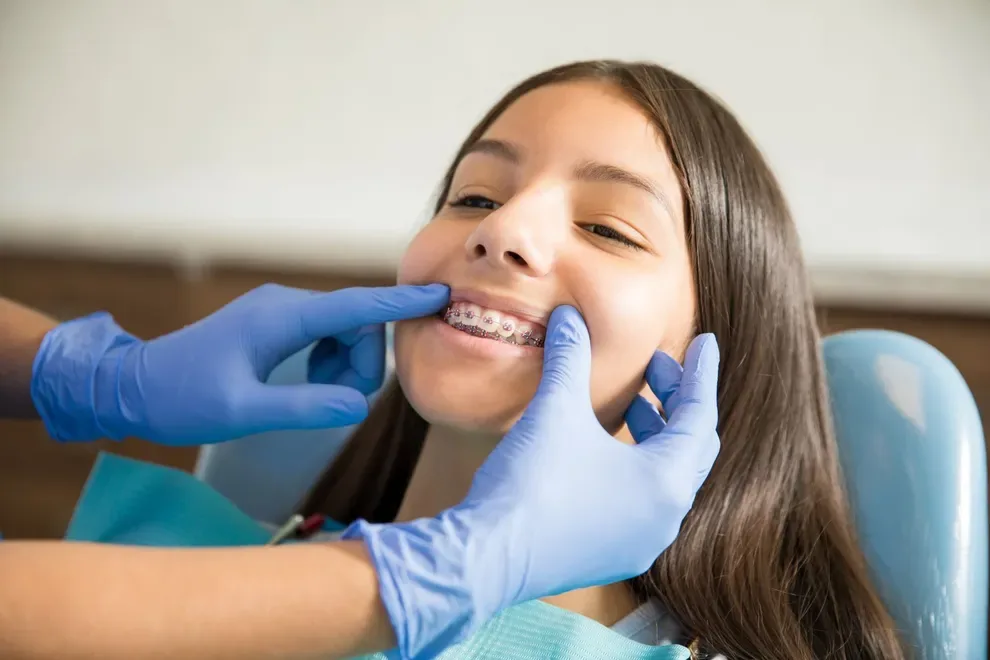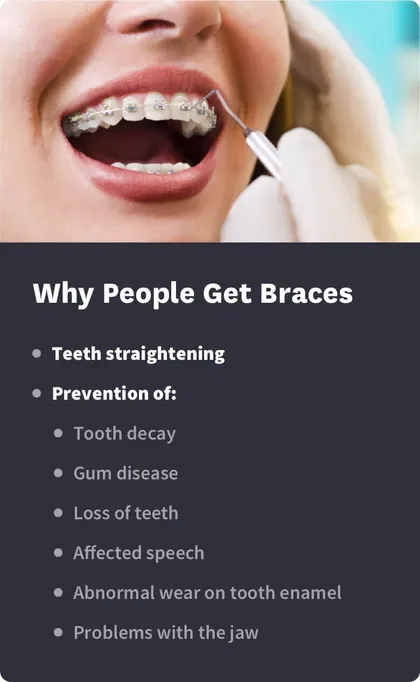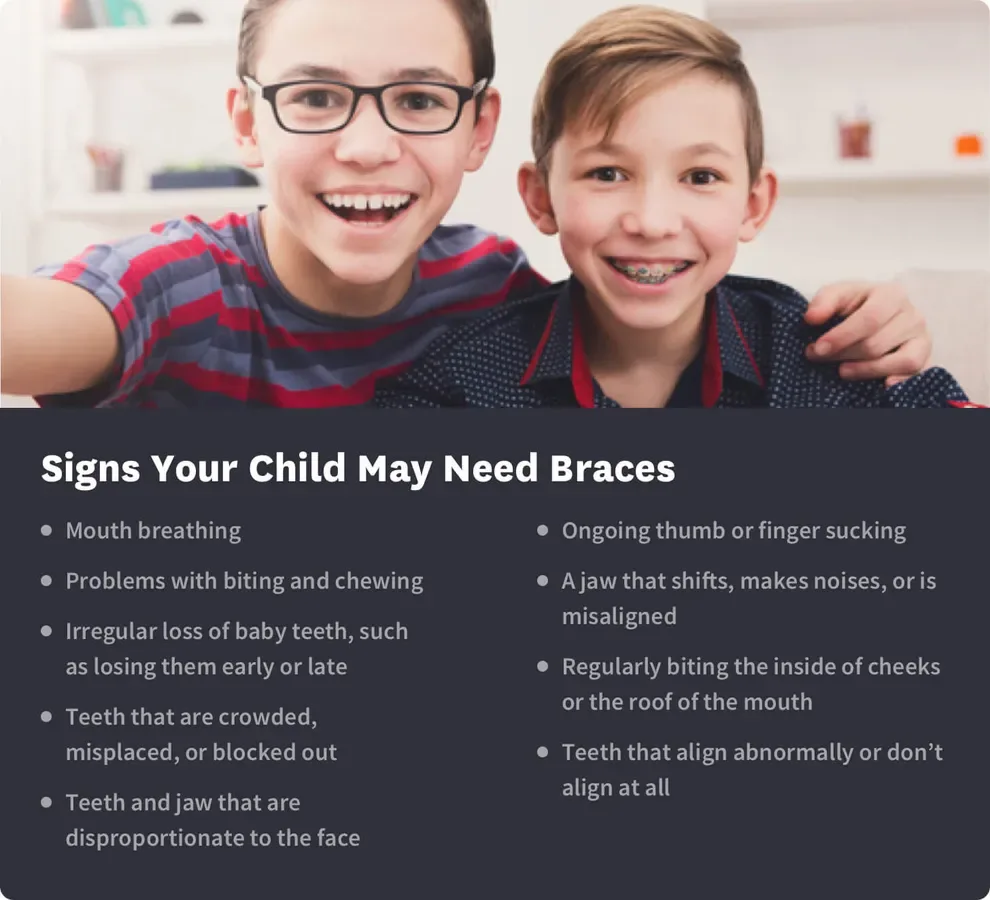At What Age Can a Child Get Braces?

Table of Contents
- Why Get Braces
- Signs for Braces
- Child Braces
- Adult Braces
- Treatment Longevity
- Getting Braces
- Alternatives to Braces
- Braces vs. Aligners for Children & Teens
The most common age range for braces is between 8 and 14 years old. There isn’t a set age when a child should get braces, as the answer varies from person to person.
The best time to get braces varies from person to person.
Most people who have braces get them during their preteen and teenage years. At this time, many adult teeth have grown in, but their bodies are still developing and responsive to change.
You don’t age out of braces. You can get them at any time throughout your life.

Why People Get Braces
Most often, braces are used when someone has a bad bite or teeth that are crooked or overcrowded. Many people assume braces are just used for straightening teeth, but there are many other reasons for getting them.
Correcting an abnormal bite can help to prevent:
Tooth decay
Gum disease
Loss of teeth
Affected speech
Abnormal wear on tooth enamel
Problems with the jaw
By straightening your teeth and properly aligning your jaw, you are achieving a nice smile and also investing in your overall oral health. If your dentist has expressed concern about your bite or tooth alignment, you may want you to consider ways to straighten your teeth and correct your bite.
Braces are not the only way to straighten teeth, though they are the most traditional option. Small brackets are cemented to your teeth and then connected by a wire that is regularly tightened in order to gradually shift your teeth and jaw into the correct positions.
Signs Your Child May Need Braces
For many kids, braces are a common part childhood. By the age of 7, your child should have a checkup with an orthodontist. Your child’s regular dentist can make a referral for you. This is just to get a baseline of how their teeth alignment looks, as many common alignment issues are evident by this point.
According to the Lucille Packard Children’s Hospital at Stanford University, signs that your child may need braces include:
Irregular loss of baby teeth, such as losing them early or late
Problems with biting and chewing
Teeth that are crowded, misplaced, or blocked out
Teeth and jaw that are disproportionate to the face
A jaw that shifts, makes noises, or is misaligned
Mouth breathing
Ongoing thumb or finger sucking
Regularly biting the inside of cheeks or the roof of the mouth
Teeth that align abnormally or don’t align at all
If you have noticed any of the above problems in your child, you do not have to wait until they are 7 to see an orthodontist. Start by consulting with your regular dentist and then seek out an opinion about braces from a licensed orthodontist.
On average, braces need to be worn for one to three years and are followed by a retainer that must be worn regularly to keep teeth in their new positions.

How Old Must My Child Be to Get Braces?
According to the American Dental Association (ADA), most people get braces between the ages of 8 and 14. By the ages of 6 to 12, it becomes relatively clear if a child has an abnormal bite.
Most often, using braces on children who are still developing leads to optimal results.
The Lucile Packard Children’s Hospital explains that the ideal age to get braces varies from customer to customer. Most commonly, orthodontic treatment begins between the ages of 9 and 14 because kids of this age already have many of their permanent teeth in, but they are not yet as set as they will be in adulthood.
Can I Get Braces as an Adult?
While most people who get braces in their lifetime get them as children, you can get braces at any time. The ADA explains that teeth can be treated with orthodontic procedures, such as braces, at any age. In fact, one in five customers at an orthodontist’s office is over the age of 18.
Adults have many reasons for seeking braces later in life. According to Colgate, reasons adults get braces include:
A desire for straighter teeth
Difficulty with brushing and flossing due to crowded teeth
Uncomfortable chewing caused by an overbite or underbite
A desire for increased confidence with a better smile
Adults sometimes have to wear braces longer than children do, as their jaws are no longer naturally developing. But the results are often the same and well worth the wait.
Do the Effects of Braces Last on Kids?
Orthodontic treatment, including braces, is highly effective and works well for most people. You must be committed to the treatment, and follow your care instructions closely in order for the treatment to be as effective as it can be.
Following braces, your child will need to wear a retainer in order to prevent their teeth from shifting back into their original positions. Orthodontic treatment is meant to be permanent, though it requires ongoing maintenance as teeth can move.
Wearing braces for as long as your orthodontist recommends, as well as diligently wearing a retainer for the recommended duration of time after braces, ensures lasting effects from orthodontic treatment.
When to Get Braces
Dental experts agree that braces work best when you have healthy teeth and gums. Age is not a terribly importance deciding factor on when to get braces, but the overall health of your mouth is.
Before you can get orthodontic treatment, you must have a healthy mouth that is free of any serious conditions, such as gum disease or damaged teeth. Children sometimes have to wait to get braces until enough of their adult teeth have grown in.
With about a third of children needing some form of orthodontic treatment, there is a chance that your child will need braces. Applying them at the right time for your child’s individual situation will help to optimize results and set them up for a lifetime of oral health.
Alternatives to Braces
For some orthodontic issues, especially those that are severe or complex, braces may be needed. Some mild or moderate orthodontic issues may be corrected with other treatment options, including these:
Retainers are removable devices that are made of plastic or metal. They are usually used to keep teeth in place, especially after braces. Sometimes an orthodontist will recommend retainer use to correct a very minor orthodontic issue, like slight crowding or a small gap between only two teeth.
Headgear is a removable appliance that’s used to correct jaw and bite problems, especially with growing teeth. Headgear can be uncomfortable and will not straighten teeth.
Palatal expanders are devices that widen the upper jaw to allow for new teeth to come in. They may cause discomfort, especially during and after orthodontic adjustments.
Clear aligners are custom-made, removable devices that fit over teeth. With aligner treatment, a scan or impression is used to create an image of a patient’s current bite and teeth placement. Using this information, a treatment plan is designed to move teeth to where they need to be for an optimal smile and bite.
A series of aligners is created. Each one is worn for over 20 hours a day, for about 2 weeks. Using gentle pressure, each aligner tray moves teeth gradually into position. After the last aligner tray, the teeth have been successfully moved and your smile is ready to impress.
Clear aligners may be an ideal choice for self-conscious teenagers with a mild or moderate orthodontic issue. They’re not only virtually invisible, but they also offer faster treatment times.
However, aligners do require commitment and discipline. They must be worn for 20 to 22 hours a day to work correctly.
Many aligner providers have an age requirement for treatment, although some offer aligner options for kids ages 6 and up.
Braces vs. Aligners for Children & Teenagers
For children and teenagers with serious or complex bite and smile issues, braces may be needed for corrective treatment. The average treatment time for braces is 1 to 3 years.
Aligners are virtually invisible and removable for cleaning and eating, which make them an appealing treatment choice for teenagers with mild or moderate orthodontic problems. They work more quickly as well, with an average treatment time of 6 months.
But their removability also could create problems during treatment if the adolescent isn’t able to keep up with wearing them as advised (usually for about 22 hours per day).
Aligners are also an option for younger children with mild or moderate orthodontic problems, as providers may offer treatment for ages 6 and up. Again, the option of removing aligners may be problematic in children’s treatment. Younger children may refuse to keep the aligners on or have trouble getting used to them.
Aligner providers may be able to adjust treatment for children to ensure more gentle pressure is applied.
If you think aligners may be right for your child, talk to an aligner treatment company or orthodontist.
